by Brian Goulding
Sixty-five years ago, Formula One aficionados were waiting for the start of a controversial new formula which had the potential to rip Formula One apart.
The new rules were announced by the FIA in 1958 to take effect from January 1961. Engine displacement was limited to 1.5-litres, as it had been for Formula 2 between 1957-1960. Self starters were compulsory as was a roll hoop behind the driver’s head.
The 2.5 litre Formula One, in force from 1954 to 1960, had witnessed a steady improvement in the fortunes of British teams culminating in Vanwall winning the inaugural Formula One Constructors Championship in 1958. The same year, Englishman Mike Hawthorn, a Ferrari driver, won the Drivers’ World Championship by a single point from Stirling Moss, but generally the F1 baton was switching from Italy to Britain.
In 1959 British cars won six GPs to Ferrari’s two. In 1960 Ferrari won just one GP and that was only due to the British teams boycotting the Italian GP at Monza (the last championship F1 race won by a front engine car). This boycott was indicative of the rift that had grown between Ferrari and the FIA on one side and the British teams on the other.
The British teams did not want their dominance in Formula One interrupted by the introduction of a new formula. They attacked the 1.5 litre formula on two fronts: firstly, they belittled the proposed new cars as small and underpowered, lacking in technical innovation, and which they believed would be dangerous because of their lack of power. At the same time the British created their own substitute formula, Formula Intercontinental, which allowed engines of up to 2.5 litres. They believed races for this formula would not only provide competition for superseded Formula One cars but provide a showcase to prove to the FIA how wrong it was to bring in the 1.5 formula.
As the time of the first championship race under the new formula approached (Monaco GP, May 14, 1961) the British finally accepted that the FIA was not going to postpone or cancel the new regulations.
Ferrari and Porsche had the advantage of being able to draw on their experience in Formula 2, where both had been successful. As soon as the new formula was announced these two teams began work on their 1961 designs. Not so the British teams which were left with no alternative other than using the underpowered 1.5 litre Coventry Climax FPF four-cylinder engine and updating current chassis as stop gaps. Even BRM, who had always used its own engines, was forced to use the Climax.
On April 25, 1961 the non-championship Syracuse GP saw the debut of the 1961 Ferrari Tipo 156 V6. It was not driven by a regular Ferrari F1 driver. It was entrusted to a former Formula Junior driver Giancarlo Baghetti. The combination won the race beating such Formula One regulars as Brabham, Clark and Moss. To add to the victory, the Ferrari was supposedly a private entry by FISA (Federazione Italiana Scuderie Automobilistiche). What would Ferrari do with real works cars driven by real GP drivers?
For the Monaco GP, Ferrari entered three cars for Ritchie Ginther, Phil Hill and Wolfgang von Trips. Porsche also arrived with three cars, but only one was a new chassis. The other two were updated 1959 F2 cars. Drivers were Joachim Bonnier (new car), Dan Gurney and Hans Hermann.
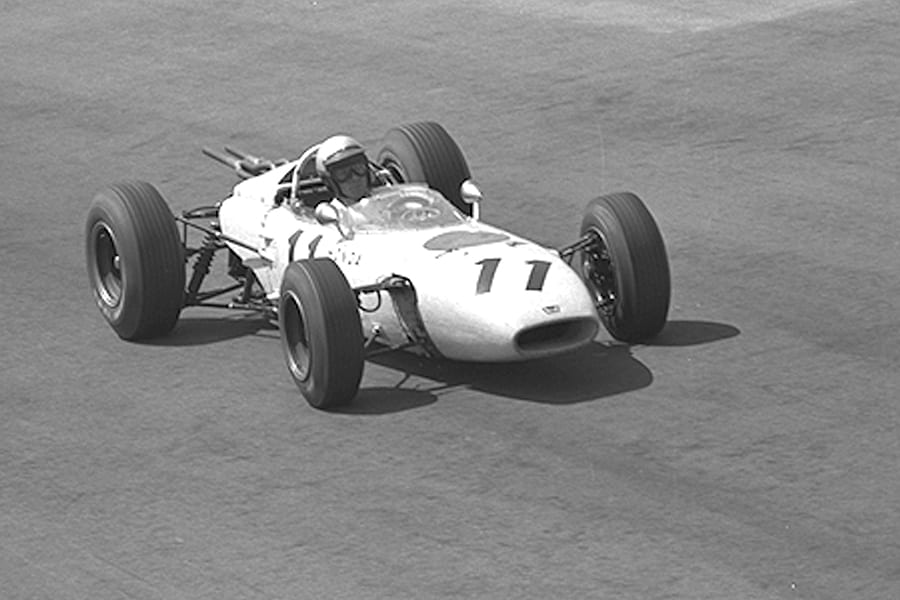
Moss took pole position in the Rob Walker Lotus 18 Climax. The Ferraris were subdued in practice (it wasn’t called qualifying in those days) filling second, third and sixth on the grid. Ginther got the jump at the start, but Moss passed him for the lead on lap 14. The race then became a battle between Moss, who was lapping only a tenth slower than McLaren’s 2.5 litre lap record, and the three Ferraris. Moss drove brilliantly in what he said was one of his best races, to hang on and beat Ginther by just 3.6 seconds after 100 laps of racing. They shared the fastest lap of 1 minute 36.3 seconds, an astonishing 2.8 seconds faster than the pole time.
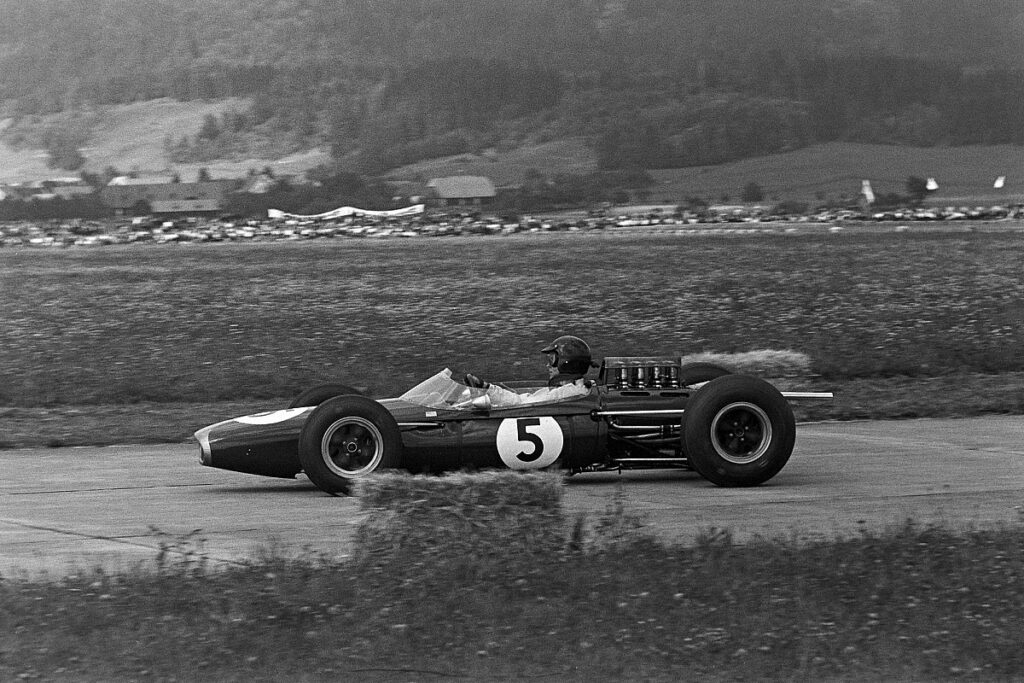
When the championship trail moved to the faster circuits the Ferraris were unbeatable. They won in Holland (1-2), Belgium (1-2-3-4), France and Britain (1-2-3). Then came a circuit where the Ferrari power advantage was not so useful, the 20.8 kms of Germany’s Nordschleife.
Jack Brabham was entrusted with the new Coventry Climax V8 engine which promised much more power than the old four-cylinder Climax. Stirling Moss was once again in the Rob Walker Lotus 18 which had now been fitted with the more aerodynamic Lotus 21 body panels. Phil Hill put his Ferrari on pole from Brabham, Moss and Bonnier in the Porsche. Moss led from start to finish in a superb demonstration of how driving skill can beat power on the right circuit. Brabham crashed on lap one so the Climax V8 was still an unknown quantity, though Jack led into the first corner.
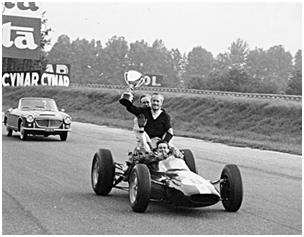
The next round was on a real power track – the combined road and banked circuit at the Autodromo di Monza. Ferrari entered four works cars and these took the first four places on the grid. Phil Hill grabbed the lead at the start but on the second lap the cars of Clark (Lotus) and von Trips (Ferrari) came together with fatal results. The Ferrari went into the crowd killing the driver and 13 spectators. Phil Hill won the race in front of a subdued crowd thus clinching the world championship for himself and the constructors championship for the Prancing Horse. The outstanding performance in the race was the fourth-place finish of the young British driver Jack Lewis. He drove an old Cooper T53 powered by a four-cylinder Climax and entered by H & L Motors. He was offered a works drive for 1963, but decided to retire instead.
The last round of the 1961 championship fell flat when Ferrari decided not to enter which meant no Phil Hill racing in front of his home crowd. Brabham and Moss set the pace, swapping the lead until the Cooper overheated and the Lotus ran its bearings. Innes Ireland inherited the lead and just held off a fast-closing Roy Salvadori who blew the motor of his Cooper on lap 96 of the 100 lap race. It was the first GP win for a works Lotus.
Had the first year of the one and a half litre formula been a success? It provided some great racing and close finishes with the smaller cars proving to be only marginally slower than the 2.5 cars they replaced. And 1961 provided some Formula One milestones. The Italian GP at Monza had the greatest number of starters in a GP at 32. Due to qualifying and prequalifying rules in later races this figure has never been equalled.
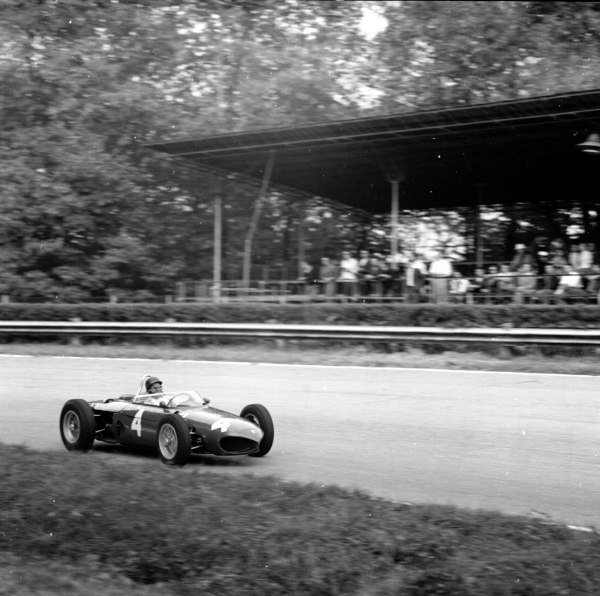
At the time the 1961 Dutch GP at Zandvoort was the only race in formula
one history where every starter finished – all 15 of them. The 1961 Oulton Park Gold Cup was the last appearance in a Formula One race by a front engined car. Stirling Moss won the event in the quirky Ferguson P99 four-wheel drive which had a four-cylinder Climax mounted in front of the driver. It helped that the track was damp.
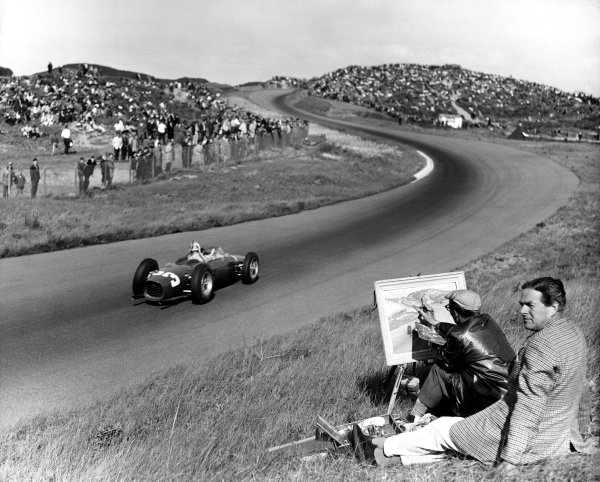
The 1.5 litre formula continued until the end of 1965 when it was replaced by a limit of three litres for normally aspirated engines and 1.5 litres for turbocharged or supercharged units.
The small rear engined designs of 1961 to 1965 needed good grip from the tyres and low drag bodies to eventually eclipse the performance of the 2.5 litre predecessors. Under the formula, engine power increased from 135 bhp from an ex-formula 2 Coventry Climax four cylinder to over 200bhp from the V12 Honda unit which won the last GP of 1965.
Tyre technology became very important, particularly when US manufacturers Goodyear and Firestone challenged Dunlop, the established supplier. In 1965 Colin Chapman of Team Lotus observed that tyres were growing wider at the rate of an inch every six months. Safety was improving thanks to the efforts of crusading drivers like Jackie Stewart. Rollover bars became more and more substantial and the wearing of seat belts became more common. On race circuits Armco fencing replaced wooden fencing or earth embankments.
It was a unique time in Formula One and an era that will never be repeated.

